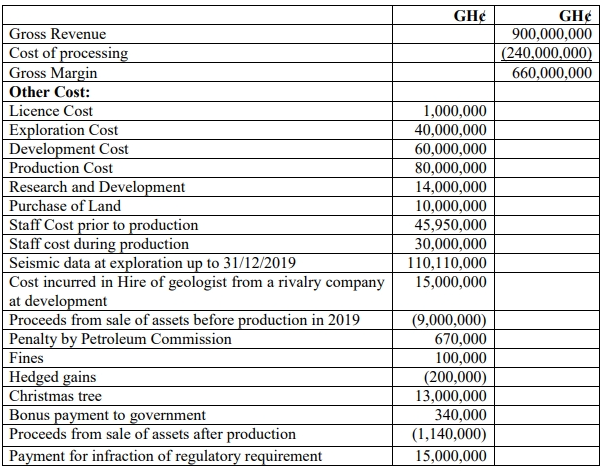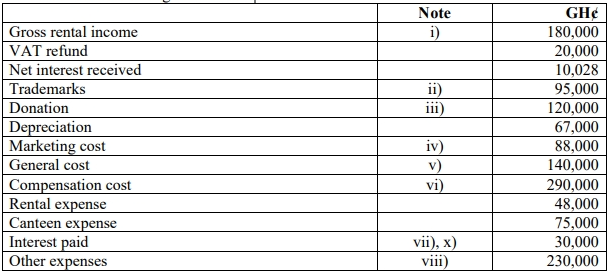Below are the summarised statements of financial position of three entities: Labone Ltd (Labone), Nungua Ltd (Nungua), and Teshie Ltd (Teshie) as at 31 December 2021.
| Statements of financial position as at 31 December 2021 |
Labone |
Nungua |
Teshie |
| Assets |
GH¢million |
GH¢million |
GH¢million |
| Non-current assets |
|
|
|
| Property, plant, and equipment |
1,150 |
800 |
400 |
| Investment in Nungua |
560 |
– |
– |
| Investment in Teshie |
60 |
– |
– |
| Other investment |
140 |
– |
– |
| Total non-current assets |
1,910 |
800 |
400 |
| Current assets |
490 |
200 |
100 |
| Total assets |
2,400 |
1,000 |
500 |
| Equity and liabilities |
|
|
|
| Equity |
|
|
|
| Equity shares of GH¢1 each |
400 |
320 |
200 |
| Retained earnings |
1,225 |
440 |
200 |
| Other reserves |
95 |
– |
– |
| Total equity |
1,720 |
760 |
400 |
| Non-current liabilities |
300 |
80 |
40 |
| Current liabilities |
380 |
160 |
60 |
| Total equity and liabilities |
2,400 |
1,000 |
500 |
Additional information:
i) On 1 January 2018, Labone acquired 80% of the equity share capital of Nungua for cash consideration of GH¢560 million. At the same date, Labone acquired 70% of the equity share capital of Teshie for cash consideration. Labone has correctly recorded both transactions. At this time, the balances on the retained earnings, the fair values of non-controlling interests, and fair values of the identifiable net assets of Nungua and Teshie were as follows:
|
Nungua |
Teshie |
| Retained earnings |
GH¢300 million |
GH¢120 million |
| Fair value of non-controlling interests |
GH¢140 million |
GH¢80 million |
| Fair value of net assets |
GH¢640 million |
GH¢310 million |
Any difference between the acquisition date fair value and book value of the identifiable net assets of both investees was due to land. Fair value adjustments should be deemed as temporary differences which are subject to tax of 20%. The fair values of identifiable net assets above are not yet adjusted for tax. Shortly after acquisition, Teshie incorporated the fair values (together with any tax effects) into its separate financial statements, but Nungua had not yet incorporated the fair values into its separate financial statements.
ii) On 1 October 2021, Labone disposed of 40% out of the 70% equity shares of Teshie for GH¢220 million. Labone credited the proceeds received to its “Investment in Teshie” and debited “Cash.” At this time, it was determined that the fair value of the remaining interest was GH¢180 million. Following the sale, Labone could only exert significant influence over Teshie.
iii) During the financial year, Labone transferred goods worth GH¢5 million every month to Teshie. By 31 December 2021, Teshie had not sold the last two months’ deliveries and had included them in its year-end inventory. Labone charges three-seventh (3/7) mark-up on all sales.
iv) Labone’s receivable balance includes GH¢12 million owed by Teshie in respect of the last three months’ sales. This balance agreed with the corresponding payables in Teshie’s financial statements.
v) In its separate financial statements, Labone has accounted for its investments in both Nungua and Teshie at cost. It is the policy of Labone group to measure goodwill in full and to record non-controlling interests at fair value at acquisition. Neither goodwill of Nungua nor that of Teshie has suffered any impairment since acquisition.
vi) Labone has two internal business segments: Construction Division and Merchandise Division. On 1 July 2021, the Construction Division entered into a 1-year fixed price contract to construct an ultra-modern office complex at a contract sum of GH¢60 million for a district government agency located in the Eastern zone of Ghana. Total estimated costs at the time the contract was concluded were GH¢52 million. Actual costs incurred up to 31 December 2021 amounted to GH¢32 million. At 31 December 2021, the Directors of Labone revised its total construction costs on the project to GH¢64 million. No progress payments have been received from the agency. The only entries made have been to include the costs incurred in Labone’s inventory. Labone measures progress to completion on the basis of cost.
vii) During the current year, Nungua and Teshie reported profits after tax of GH¢48 million and GH¢40 million respectively. Unless otherwise stated, it may be assumed that profits accrued evenly over the year and that no dividends were paid during the year.
(Note: Deferred tax adjustment should be ignored, unless otherwise indicated.)
Required:
Prepare the consolidated statement of financial position of the Labone Group as at 31 December 2021.





